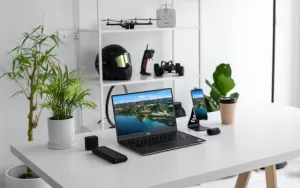In today’s world, ensuring the security of your home is absolutely essential. Home security camera systems offer peace of mind by allowing you to monitor your property remotely and deter potential intruders. With various options available, it’s crucial to select a system that meets your specific needs and preferences.
Understanding Your Security Needs
Before choosing a home security camera system, take time to evaluate your security requirements. Consider the size of your property, the specific areas you want to monitor (e.g., front porch, backyard), and any additional features you may need, such as night vision or two-way audio.
Types of Home Security Cameras


When selecting a home security camera system, understanding the different types available can help you choose the right one based on your specific needs and preferences:
- Indoor Cameras:
Indoor cameras are designed to be used inside homes or buildings. They are typically smaller and more discreet, focusing on capturing activity within specific rooms or areas like living rooms, bedrooms, or hallways. - Outdoor Cameras:
Outdoor cameras are built to withstand outdoor elements such as rain, wind, and temperature fluctuations. They are weatherproof and often come with features like infrared night vision to monitor outdoor spaces like driveways, gardens, and entrances. - Dome Cameras:
Dome cameras are named for their dome-shaped housing. They are versatile and often used in both indoor and outdoor settings. The dome shape makes it difficult for intruders to determine where the camera is pointing, providing a level of discreet surveillance. - Bullet Cameras:
Bullet cameras have a cylindrical, bullet-like shape. They are typically used outdoors and are highly visible, acting as a deterrent to potential intruders. Bullet cameras are renowned for their extensive visibility range, making them perfect for overseeing expansive areas such as parking lots or yards. - Wireless Cameras:
Wireless cameras transmit video and audio signals wirelessly to a receiver, which connects to your recording device or network. They offer flexibility in installation and placement without the need for extensive wiring, making them easier to install and relocate. - Wired Cameras:
Wired cameras require a physical connection to a power source and a recording device or monitor. They offer a stable connection and are generally more reliable in terms of signal transmission, making them suitable for areas where consistent surveillance is critical. - Smart Cameras:
Smart cameras are equipped with built-in features such as motion detection, facial recognition, and integration with smart home systems. They can send alerts to your smartphone or device, allowing you to monitor your home remotely and respond to events in real-time. - Thermal Cameras:
Thermal cameras detect infrared radiation (heat) emitted by objects and people. They are effective in low-light or no-light conditions and can detect movement based on temperature changes, making them ideal for enhanced security in areas with poor visibility. - Covert Cameras:
Covert cameras are designed to be discreet and blend into their surroundings, making them less noticeable to intruders. They can be hidden in everyday objects like smoke detectors or clocks, providing covert surveillance without alerting potential threats.
Features to Consider
When choosing a home security camera system, understanding the key features can help you determine which system best meets your security needs:
- Resolution: The resolution of a camera determines the clarity of the video footage. HD (High Definition) and 4K options offer higher resolution, providing sharper images and better detail, which is crucial for identifying faces or license plates.
- Field of View: A wide field of view allows the camera to cover more area without compromising detail. Cameras with a broader field of view are ideal for monitoring large spaces such as yards or parking lots, reducing the number of cameras needed for comprehensive coverage.
- Night Vision: Night vision capabilities are essential for surveillance in low-light or nighttime conditions. Infrared LEDs illuminate the area without attracting attention, ensuring clear visibility of intruders or activities in the dark.
- Motion Detection: Motion detection technology triggers alerts or recordings when motion is detected within the camera’s field of view. This feature is invaluable for alerting you to potential threats or suspicious activity, enhancing overall security effectiveness.
- Audio Capabilities: Two-way audio allows for communication between you and whoever is near the camera. This feature enables you to speak to visitors, delivery personnel, or potential intruders, providing an additional layer of security and convenience.
- Pan-Tilt-Zoom (PTZ) Functionality: PTZ cameras offer flexibility in monitoring by allowing you to pan (move horizontally), tilt (move vertically), and zoom in on specific areas or objects. This capability is beneficial for tracking moving subjects or obtaining detailed views of distant objects.
- Connectivity and Integration: Ensure your home security camera system integrates with smart home platforms like Alexa or Google and provides remote monitoring via smartphone apps or web interfaces for real-time security updates.
- Storage and Recording: Consider how video footage is stored and managed. Some cameras offer local storage options such as SD cards or onboard storage, while others use cloud storage services. Evaluate the costs and benefits of each option, including accessibility and security of stored footage.
These features collectively determine the functionality and effectiveness of a home security camera system. By evaluating and prioritizing these features based on your specific security requirements and preferences, you can choose a system that enhances the safety and protection of your home and family.
Researching Available Options
When choosing a home security camera system, it’s important to do your homework. Start by checking out top brands known for reliability and great customer support. These brands invest in quality engineering, making products that can handle different weather conditions over time. Reading reviews and comparisons is key too. They give you real insights from users and experts on things like video quality, how easy the cameras are to set up, app features, and customer service experiences. By looking at both expert opinions and what actual users say, you’ll find the right home security camera system that fits your needs and gives you peace of mind.
Budget Considerations
When it comes to budgeting for a home security camera system, you’ve got options that fit different price ranges. These systems can range from budget-friendly choices to more premium setups. One thing to think about is whether to buy outright or consider alternatives like leasing or “buy now, pay later” financing. These options can help spread out the upfront costs while still getting you a top-notch system that meets your needs.
It’s also important to balance the features you want with what you can afford. Focus on essential features that enhance your security without breaking the bank. This approach ensures you get the best value for your money and a system that’s both effective and within your budget.
Conclusion
Choosing the right home security camera system involves evaluating your security needs, budget constraints, and desired features. By carefully considering these factors and researching available options, you can select a system that provides the security and peace of mind you deserve.
Visit Approovl to discover flexible financing options in partnership with Klarna and Acima, allowing you to acquire the best security devices through easy installments, making home security more accessible.



